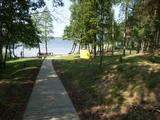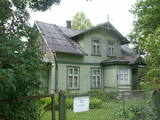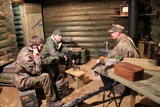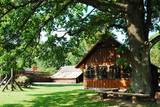| Nr | Name | Beschreibung |
|---|---|---|
|
Dort befindet sich ein kleines Gebiet auf der Westseite des Sees Būšnieks, das eingerichtet wurde, um den Sumpfbiotop und die seltenen Pflanzen zu schützen. Gut ausgestattete Erholungseinrichtungen befinden sich am gegenüberliegenden Ufer des Sees.
|
||
|
Das Museum von Miervaldis Ķemers (1902
– 1980) – das dem bekannten lettischen
Kulturaktivisten, Pfarrer und Maler gewidmete
Memorialmuseum auf der Durbes Straße 211
|
||
|
Atrodas t.s. Baznīcu kalnā - A. Pumpura ielā 11 a. Varenais neobaroka stilā celtais dievnamu tapis 1905. g. Pastāv viedoklis, ka par šīs baznīcas prototipu izmantotas Aglonas vai Krāslavas bazilikas, kā arī Rietumeiropas baznīcu paraugi. Tās interjeru rotā divstāvīgs altāris, kurā novietota spāņu gleznotāja B. E. Muriljo pazīstamās gleznas “Svētā Dievmāte” kopija. 1909. g. baznīcā uzstādīja poļu meistara Ādolfa Hofmana būvētās ērģeles.No būvniecības laika saglabājusies arī pārējā baznīcas iekārta. |
||
|
The shadowy cellar of the estate is a great place to hear about how homemade wine is made. You can taste rhubarb, black currant and strawberry wine along with local goodies such as cheese. Local farmers provide the ingredients for the wine. |
||
|
Where the little Rumbiņa river flows into the Daugava (on the left bank of the little river opposite the Lielvārde park), there is the Dievkalns castle hill that has been reduced by the waters of the Daugava. It is also known as the Cepure hill. According to antiquities that have been found here, representatives of Baltic tribes lived here from the first millennium BC to the 6th or 7th century AD. The level of the Ķegums hydroelectric power plant can be reached by a staircase from which the best view of this object can be found.
|
||
|
Pie Vidzemes šosejas pirms Melturu tilta pāri Amatai ir privātais muzejs "Mežabrāļu bunkurs". Bunkurs izveidots, lai varētu vēstīt par Nacionālo partizānu mežabrāļu cīņu laikā no 1944.-1956. gadam, kad mežos pret okupācijas varu cīnījās ap 20 000 Latvijas patriotu. Nacionālo partizānu bunkurs izveidots balstoties uz savāktajām mežabrāļu atmiņām, dienasgrāmatu pierakstiem un fotogrāfijām. Uz bunkuru ved meža taka ar informāciju par dažādiem mežabrāļu piedzīvojumiem un cīņām. Bunkura pazemes daļā apskatāmi vēsturiskie priekšmeti, kas viņus pavadīja dzīvē un cīņā. Saimnieks piedāvā pastaigu pa meža taku, kur izvietota informācija par mežabrāļiem un slēpņu spēle bērniem. Ar iepriekšēju pieteikšanos iespējams iekļūt bunkurā un apskatīt iekārtotu bunkuru ar mežabrāļu izmantoto ieroču, munīcijas un citu priekšmetu ekspozīciju. Stāstījumu papildina savāktās mežabrāļu interviju videoieraksti. Apmeklētājiem iespējams pasūtīt mednieku desiņu cepšanu lapenē pie bunkura. |
||
|
Pareizticība Traķu apkārtnē „ienāca” jau Lietuvas dižkunigaiša Ģedimina (Gediminas) valdīšanas laikā (1316. – 1341.). Līdz 18. gs. beigām no astoņām pareizticīgo baznīcām Traķos nebija saglabājusies neviena, tādēļ pareizticīgo draudze 1863. g. uzcēla jaunu baznīcu, kas saglabājusies līdz mūsdienām un apskatāma Vitauta ielā (Vytauto gatve) 32. |
||
|
Die orthodoxe Kirche des Heiligen Geistes und das Männerkloster, sowie die sich auf dem Gelände des Klosters befindliche orthodoxe Kirche des Heiligen Nikolaus des Wundertäters befinden sich in Jēkabpils, in der Brīvības Straße 200. Die byzantinisch-orthodoxe Kirche des Heiligen Geisteswurde von 1853 bis 1886 gebaut, aber die vorigen Kirchen wurden im 17. Jh. an der Stelle des im Jahr 1773 abgebrannten Gotteshauses gebaut, für dessen Bau der kurländische Herzog Jakob Holz zur Verfügung gestellt hatte. An der Kirche befand sich der Männerkloster des Heiligen Geistes, aber im Jahr 1903 brach zu Ostern in dem Kloster ein Feuer aus, in dem nur das Gemälde der Jungfrau Maria erhalten blieb. Die Kirche hat im Ersten Weltkrieg gelitten, aber sie wurde im Jahr 1933 erneuert. Neben der Kirche des Heiligen Geistes befindet sich das älteste Gotteshaus von Jēkabpils – die im Jahr 1774 gebaute gemauerte Kirche, die im Namen des Heiligen Nikolaus des Wundertäters genannt ist. Diese Kirche zeichnet sich durch ihre kleinen Maße (17 x 19,5 Meter) aus. Heute haust hier das Kloster der orthodoxen Kirche des Heiligen Geistes, den man auch von innen besichtigen kann. Dieser Gebäudekomplex ist von einem eindrucksvollen und den lettischen Städten nicht charakteristischen Mauerzaun aus dem 17. Jh. eingeschlossen. |
||
|
Auf diesem Gelände kann man hervorragende Denkmäler besichtigen, die im ganzen Baltikum bekannt sind und die eine Geschichte von fast 1000 Jahren schildern: Das Landgut von Turaida (ein typisches Landgut der Region Vidzeme), die evangelisch-lutherische Kirche von Turaida, die eine der ältesten Kirchen (1750) aus Holz in Lettland ist, der Hügel Dainu kalns (Volksliederberg), der dem 150. Jubiläum des Sammlers der lettischen Volkslieder Krišjānis Barons gewidmet ist, und die gemauerte Burg von Turaida. Hier kann man die Kultur der Liven dieser Region kennenlernen, die Geschichte in Bildungsprogrammen erkunden, sowie jährliche Veranstaltungen besuchen, die mit Folklore und Völkerkunde verbunden sind. |
||
|
Tour groups with at least ten people can enjoy tastings of various homemade wines (23 types in all) that are made of fruits and berries – three types of wine each time. The owner will tell you about winemaking technologies and ways to drink and enjoy wine. |
||
|
Autentiskā Zypliu muižas vidē izveidots restorāns. Kulinārais mantojums - Lietuvas muižniecības ēdieni. Ēdināšana, degustācija, izglītības programmas. |
||
|
Befindet sich im Zentrum der Ortschaft Piņķi, an der Rīgas Straße. Das Denkmal ist den Ereignissen des Jahres 1919 gewidmet, wenn am 22. Mai nach einer fast zweimonatigen Ruheperiode ging die Brigade des Obersten Balodis in die Offensive, um die Hauptstadt Rīga von den Bolschewiken zu befreien. Eine Unterstützung für die Brigade des Obersten Balodis sollten sowohl Deutsche Landeswehr und Eiserne Division als auch Russische Abteilung des Fürsten Lieven geben. Das erste Denkmal wurde vom Präsident der Republik Lettland Kārlis Ulmanis am 23. Mai 1939 eröffnet. Im Jahre 1951 hat die sowjetische Macht das Denkmal vernichtet, aber im Jahre 2003 wurde eine Kopie des Denkmals errichtet (Bildhauer J. Briedis, Kopie von O. Skarainis). |
||
|
Saimniecības laukos ganās ap 300 aitu kupls ganāmpulks, no kura iegūst gaļu un vilnu. Piedāvā ekskursiju, kurā stāsta par aitu audzēšanu, cep maizi, auž un uz ugunskura vāra zupu. Apmeklētāji var iegādāties adītas zeķes, cimdus, segas, lakatus, galdautus un citas saimniecībā noderīgas lietas. Stāsta par atjaunotās mājas vēsturi un kopj latviskās tradīcijas. |
||
|
Another monument designed by Kārlis Zemdega, this one was installed in 1937 and was initially known as a monument to soldiers who liberated and fell in Rūjiena. The monument survived the Soviet era only because a statue of Lenin that was across the street was on a high pedestal and thus overshadowed the monument to the trumpeter of Talava. |
||
|
Dodieties ekskursijā, lai gūtu ieskatu lauku profesijā un dzīvesveidā, kā arī iegūtu jaunus iespaidus un labu atpūtu visai klasei. Ekskursijas laikā apmeklējiet kokapstrādes darbnīcu, kurā ražo visu saimniecībā nepieciešamo – solus, galdus, pakaramos, virtuves piederumus, pirts baļļas, mucas, lieliskus suvenīrus no koka u.c. Pēc tam apmeklējiet zemnieku saimniecību, kura ir viena no lielākajām un modernākajām zemnieku saimniecībām Zemgalē. Izbaudiet pusdienu pikniku Tērvetes dabas parkā. Ekskursijas noslēgumā dodieties uz maizes ceptuvi, lai izzinātu maizes cepšanas arodu, degustētu un iegādātos maiznīcas izstrādājumus. |
||
|
This chapel is interesting in form and made of field stones. It was built in the 19th century and is not open to the public. |
||
|
Lots of wild animals can be found in vast paddocks along the ancient Gauja river valley and its small tributaries – areas in which living conditions are as close to natural circumstances as possible. Here the visitor can find, if lucky, reindeer, deer, wild boars, bears, foxes, lynx, various kinds of birds, as well as aurochs. There is a dense network of pathways in the park, including lots of information. There is also a route for drivers and bicyclists. During the winter, it is used for distance skiing. There is also a visitors’ centre.
|
||
|
Vieta Suvalkijā ģimenes svinībām un atpūtai laukos. Atjaunotajā ar vēsturi saimniecībā atradīsiet etnogrāfisku un modernu interjeru elementu sajaukumu. Plaša dzīvojamā istaba ar kamīnu, oriģinālas ozolkoka mēbeles, guļamistabas ar visām ērtībām un virtuvi. Lauku pirts un kubls. Mežs pie mājas bagāts ar sēnēm un ogām. Piedāvājumā izglītojošas aktivitātes, stafetes bērniem un viņu vecākiem līksmībai, pirtnieka pakalpojumi.
|
||
|
Храм неоднократно горел и строился снова. Теперешняя церковь построена в 1874 году, а после пожара 1927 года была восстановлена в 1932 году. Можно осмотреть алтарную икону«Иисус со святым причастием», две картины И. Зебериньша «Иисус у креста» и «Иисус благословляет детей» (1957 г.). Проспект органа является первым, построенным в «латышском» вкусе органом (резчик по дереву П. Планкус, 1936 г.), а сам инструмент номинирован как самая красивая и самая объемная работа лиепайского мастера Екаба Яугиеша. Трубы органа сделаны из дерева, что является редким случаем. Церковь можно осмотреть изнутри. |
||
|
The café is in the historical centre of Tukums and offers various Latvian baked goods and pastries. |
||

















